Standedge Tunnels
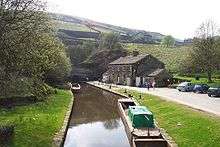 Tunnel End Cottages and the entrance portal at Marsden | |
| Overview | |
|---|---|
| Location | Standedge |
| Coordinates | 53°35′28″N 1°57′44″W / 53.59107°N 1.96219°WCoordinates: 53°35′28″N 1°57′44″W / 53.59107°N 1.96219°W |
| OS grid reference | SE026105 |
| Status | Open |
| Waterway | Huddersfield Narrow Canal |
| Start | 53°34′05″N 1°59′34″W / 53.568042°N 1.992684°W |
| End | 53°36′13″N 1°56′33″W / 53.603622°N 1.942506°W |
| Operation | |
| Constructed | 1794–1811 |
| Opened | 1811 |
| Closed | 1944 |
| Rebuilt | 2001 |
| Owner | Canal & River Trust |
| Technical | |
| Design engineer |
Nicholas Brown Thomas Telford |
| Length | 5,500 yards (5,029 m) |
| Towpath | No |
| Boat-passable | Yes (with permission) |
The Standedge Tunnels are four parallel tunnels beneath the Pennines in northern England. Three are railway tunnels and the other is a canal tunnel. They are located at the Standedge (pronounced Stannige) crossing point between Marsden and Diggle, across the boundary between the West Yorkshire and Greater Manchester conurbations. Before boundary changes in 1974, both ends of the tunnel were in the West Riding of Yorkshire.
The canal tunnel is a key part of the Huddersfield Narrow Canal. Having been authorised by an Act of Parliament on 4 April 1794, construction work commenced on what was anticipated to be a 5,456-yard (4,989 m)-long tunnel only months thereafter. Within two years, several cost-saving measures were enacted which pushed back the envisioned completion date; work was also negatively impacted by the high levels of water encountered, which were much greater than had been expected. Amid this, it proved difficult to secure skilled help; some contract tenders went unanswered while figures like Benjamin Outram chose to withdraw from the venture. During 1807, the famed civil engineer Thomas Telford established a new detailed plan of work for the initiative; this was successfully and strictly followed throughout the rest of construction. During 1811, the tunnel finally opened; it is the longest and oldest of the four and is the longest and highest canal tunnel in the United Kingdom.[1] Having been closed to all traffic in 1943, the canal tunnel was later re-opened during May 2001.
The first, single-track railway tunnel, built for the London and North Western Railway (LNWR) on their line between Huddersfield and Manchester, was completed during 1848. However, it quickly proved to have insufficient capacity and a second, parallel, single-track tunnel was opened during 1871. Finally, the LNWR opened a third, double-track tunnel nearby on 1894. All four of the tunnels are linked by a series cross-tunnels or adits located at strategic intervals, which had allowed the railway tunnels to be built quickly by reducing the need for construction shafts, and allowed for waste materials to be removed by boat. Of the railway tunnels, only the one double-track tunnel completed in 1894 is currently used for rail traffic; the others remain intact but are presently disused. The Standedge Tunnel Visitor Centre, at the Marsden end, serves as a base for boat trips into the tunnel, as well as host to an exhibition depicting the different crossings.
Canal tunnel
Standedge Tunnel | |||||||||||||||||||||||||||||||||||||||||||||||||||||||||||||||||||||||||||||||||||||||||||||||||||||||||||||||||||||||||||||||||||||||||||||||||||||||||||||||||||||||||||||||||||||||||||||||||||||||||||||||||||||||||||||||||||||||||||||||||||||||||||||||||||||||||||||||||||||||||||||||||||||||||||||||||||||||||||||||||||||||||||||||||||||||||||||||||||||||||||||||||||||||||||
|---|---|---|---|---|---|---|---|---|---|---|---|---|---|---|---|---|---|---|---|---|---|---|---|---|---|---|---|---|---|---|---|---|---|---|---|---|---|---|---|---|---|---|---|---|---|---|---|---|---|---|---|---|---|---|---|---|---|---|---|---|---|---|---|---|---|---|---|---|---|---|---|---|---|---|---|---|---|---|---|---|---|---|---|---|---|---|---|---|---|---|---|---|---|---|---|---|---|---|---|---|---|---|---|---|---|---|---|---|---|---|---|---|---|---|---|---|---|---|---|---|---|---|---|---|---|---|---|---|---|---|---|---|---|---|---|---|---|---|---|---|---|---|---|---|---|---|---|---|---|---|---|---|---|---|---|---|---|---|---|---|---|---|---|---|---|---|---|---|---|---|---|---|---|---|---|---|---|---|---|---|---|---|---|---|---|---|---|---|---|---|---|---|---|---|---|---|---|---|---|---|---|---|---|---|---|---|---|---|---|---|---|---|---|---|---|---|---|---|---|---|---|---|---|---|---|---|---|---|---|---|---|---|---|---|---|---|---|---|---|---|---|---|---|---|---|---|---|---|---|---|---|---|---|---|---|---|---|---|---|---|---|---|---|---|---|---|---|---|---|---|---|---|---|---|---|---|---|---|---|---|---|---|---|---|---|---|---|---|---|---|---|---|---|---|---|---|---|---|---|---|---|---|---|---|---|---|---|---|---|---|---|---|---|---|---|---|---|---|---|---|---|---|---|---|---|---|---|---|---|---|---|---|---|---|---|---|---|---|---|---|---|---|---|---|---|---|---|---|---|---|---|---|---|---|---|---|---|---|---|---|---|---|---|---|---|---|---|---|---|---|---|---|---|---|---|---|---|---|---|
| |||||||||||||||||||||||||||||||||||||||||||||||||||||||||||||||||||||||||||||||||||||||||||||||||||||||||||||||||||||||||||||||||||||||||||||||||||||||||||||||||||||||||||||||||||||||||||||||||||||||||||||||||||||||||||||||||||||||||||||||||||||||||||||||||||||||||||||||||||||||||||||||||||||||||||||||||||||||||||||||||||||||||||||||||||||||||||||||||||||||||||||||||||||||||||
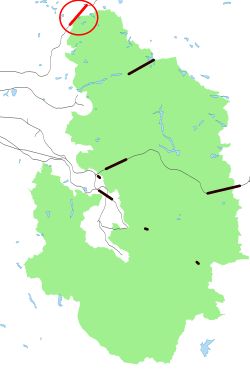
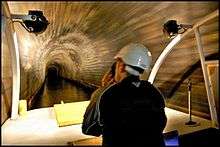
Construction
On 4 April 1794, the construction of the Huddersfield Narrow Canal (then known as the Huddersfield Canal), which was to link the towns of Ashton-under-Lyne and Huddersfield via a tunnel, was officially authorised by an Act of Parliament.[2] Civil engineer and surveyor Benjamin Outram was appointed as the consulting engineer for the endeavour; his report during October 1793 estimated the cost of the canal and tunnel at £178,478. Nicholas Brown surveyed the canal's intended route. Outram thought that the hill through which the tunnel was to be cut was composed of gritstone and strong shale, and therefore should not present any difficulties. He expected to start work on the 5,456-yard (4,989 m) tunnel at a dip in the hill at Red Brook, intending to dig out the bore simultaneously from both ends, while using steam engines to keep the works drained during construction.[3]
Accordingly, work commenced with Outram acting as the site engineer while Brown served as both superintendent and surveyor. During July 1795, John Evans was appointed to manage the boring of the tunnel. By mid-1796, 795 yards (727 m) of tunnel had been cut, some of which had been lined; however, considerable effort had been spent on constructing small tunnels to supply waterwheels which would raise spoil and water from the intermediate adits.[2] By the autumn, there was concern that such work was expensive but had not contributed anything to the task in hand and soon afterwards, Outram chose to abandon further attempts to build extra workfaces and instead concentrate on mining the bore out from both ends. Although cheaper, this decision had the consequence of extending the tunnel's completion date.[4]
Further factors had also played a role in slowing progress in the tunnel's construction; according to author Graeme Bickerdike, both a shortage of funding and poor working practices were major contributing causes.[2] As a direct result of early cutbacks in drainage, the tunnelling process was hampered by much larger quantities of water entering the workings than had been expected. During September 1797, Outram advised the management committee that Thomas Lee, the first contractor to be employed on the tunnel works, had made large losses as a result of the difficulties and could not complete his contract. He was awarded more money for timber, an increased rate per yard for completion and an extra year in which to finish the tunnel.[4]
By the middle of 1799, 1,000 yards (910 m) of the tunnel had been finished and a further 1,000 yards (910 m) had been excavated, but it had not been completed. During October 1800, the Peak Forest Canal Company, who were keen to trade through the tunnel, suggested that a tram road should be built to bypass the tunnel until it was completed; although Outram is known to have studied this option, no action was ultimately taken to pursue this alternative. The next tunnel contract failed to attract any takers, thus canal engineer John Varley, who had already been involved in the repair work to parts of the canal which had been damaged by floods, was asked to perform tunnelling work as well. Soon thereafter, the experienced mine owner and engineer Matthew Fletcher was asked to present his opinion of the project; he suggested that time could be saved by tunnelling in both directions from Redbrook pit, which was being kept dry by a large steam engine. He estimated that this would cost an additional £8,000 but, although the committee tried to find a contractor to carry out the work, none could be found and thus tunnelling continued from both ends.[5]
During 1801, Outram resigned from the project after work had been brought to a stop for a lengthy period.[6] Brown was also dismissed from his role.[2] In late 1804, the committee began to address the issue of how the tunnel would be worked, during which a sub-committee visited the Harecastle Tunnel on the Trent and Mersey Canal, the Butterley Tunnel on the Cromford Canal and the Norwood Tunnel on the Chesterfield Canal. After these viewings, the committee recommended that a towing path should be built through the tunnel; however, the extra cost and delay to completion were not things that the company was able to afford. Desperately short of money, the canal company obtained a new Act of Parliament during 1806 to raise additional finance and to allow an extra toll for using the tunnel to be charged.[7] In 1807, famed civil engineer Thomas Telford was asked for his advice on both construction and planning for the project; in response, Telford produced his own detailed plan, which was carefully followed until the work was completed.[6]
On 9 June 1809, the two ends of the tunnel finally met.[2] Nearly two years after that, on 26 March 1811, the tunnel was declared to be complete and a grand opening ceremony was held on 4 April; a party of invited guests, followed by several working boats, entered the tunnel at Diggle and completed the journey to Marsden in one hour and forty minutes. The Standedge Tunnel had cost around £160,000, which meant it was the most expensive canal tunnel to have ever been built in Britain.[7] It was also the longest, deepest and highest canal tunnel in Britain. The tunnel is 5,500 yards (5,000 m) long, 636 feet (194 m) underground at its deepest point, and 643 feet (196 m) above sea level.[8]
Operation
When the Standedge Tunnel eventually opened, it enabled the canal to become a through route, 13 years after the rest of the route had been completed and 17 years after work first began, at a total cost of £123,803. Despite multiple problems, the building of the Huddersfield Narrow canal showed that the technique of quantity surveying had advanced greatly. Telford's report covered every expenditure to the last bucket - it was followed to the letter until the canal finally opened. Between 1811 and 1840, the tunnel was used on average by 40 boats daily.[9] The canal tunnel is brick-lined in some places, though some sections of bare rock were left exposed.[10]
The canal tunnel is only wide enough for one narrowboat for much of its length and to save on cost, as in some other canal tunnels in England, a tow-path was not provided in the tunnel. As canal boats were horse-drawn upon its opening, the boats had to be legged through the tunnel – a process where one or more boatmen lay on the cargo and pushed against the roof or walls of the tunnel with their legs. Professional leggers were paid one Shilling and six Pence for working a boat through the tunnel which took one hour and twenty minutes for an empty boat and three hours with a full load.[11] According to Bickerdike, the limited load capacity and the lack of a tow-path in the tunnel damaged the competitiveness of the whole route in comparison to the rival Rochdale Canal, which was located only a few miles to the north and directly completed with the narrower Huddersfield Canal for business.[2]
There are several widened points in the tunnel, which were originally designed to function as passing places when handling bi-directional traffic. However, operational experiences saw intense competition between boat crews hindering such activities, thus two-way operation in the tunnel was determined to be impractical. In its place, the canal company decided to introduce a new method of working, for which one end of the tunnel would be closed off by a locked chain to prevent any access to the tunnel unless authorised. A similar arrangement has remained in use for the present day.[10]
During 1846, the Huddersfield Narrow Canal was purchased by the Huddersfield & Manchester Railway. The existing canal tunnel proved most beneficial in assisting with the construction of the first railway tunnel at this location as it meant that no vertical shafts would be needed during the construction process; the canal also provided an easy method of removing the large amount of spoil that was excavated by the work. Following the railway tunnels completion, several of the cross-passages were retained.[10]
It has been reported that the last commercial boat to use the tunnel passed through during 1921; the canal was officially closed to traffic during 1944, after which maintenance activity ended and the tunnel soon fell into a state of disrepair. Some have claimed that the last boat to successfully pass through the tunnel prior to its restoration was the Rolt/Aickman expedition in the leaky Ailsa Craig in 1948, at which point the tunnel's condition was unmaintained:[10] writing in 1948, literary figure and engineering enthusiast L. T. C. Rolt stated that he had recently traversed the tunnel, and described the journey to have taken two hours, during which the speed was intentionally kept very low so as to avoid damage to the boat.[12]
During the following years, the canal was obstructed at several locations on both sides of the Pennines; as the tunnel had become unsafe, it was closed by large iron gates located at each end. A local newspaper described a trip organised by the Railway and Canal Historical Society during 1961, which was held to commemorate 150 years since building work on the canal had been completed. This expedition used a single narrowboat, which departed Marsden around 11 a.m. and emerged from the Diggle portal around 1 p.m.[13]
Restoration
During the 1990s, amid a national boom in canal tourism, the canal tunnel was the beneficiary of a £5 million restoration project as part of a wider effort to re-open the entire canal. Several rock-lined parts of the tunnel were found to be unstable; to address these problem points, these were stabilised by rock bolts where possible,while concrete was used to stabilise the rock face where the former measure proved to be impractical. During May 2001, the tunnel was officially re-opened to traffic.
Unlike its original traffic, the majority of modern canal boats are diesel-powered. When the canal was reopened, it was felt that it would not be safe for boaters to navigate the tunnel under their own diesel power due to the extreme length of the tunnel and the lack of ventilation. Instead, electric tug boats are used to haul narrowboats through the tunnel.[14] Typical operation was to tightly bind three or four boats together in a long row with the electric tug at the head, after which the cavalcade would proceed slowly through the tunnel while the boat crews would travel in the tug as a British Waterways operative steered the last boat in the chain; no personnel was allowed to travel on the intermediate boats while in the tunnel. Despite the use of rudimentary protection measures, such as strips of thick rubber conveyor belting being put in place on the boat gunwales and roofs, extensive impact damage to the intermediate unsteered boats was quite common with this method of working.
During September 2007, it was identified that significant repairs were required to one of the electric tug modules; as such, British Waterways carried out a trial run for self-steer operation. The trip boat Pennine Moonraker was taken through the tunnel under her own power by owner John Lund, shadowed by a BW electric tug. Since the 2009 season, boats have been allowed to travel through the tunnel under their own power, albeit with an experienced chaperone onboard to guide its passage, followed by a service vehicle through one of the parallel disused railway tunnel.[15][16]
Railway tunnels
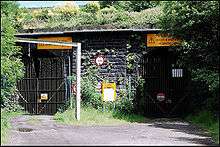
There are a total of three railway tunnels running parallel to each other and the canal tunnel. The railway tunnels are level for their whole length, which also had the early operational benefit of providing the only section of level track on the line where water troughs could be installed to provide steam locomotives with fresh water supplies without the requirement for the train to stop. Both of the single-track bores, akin to the canal tunnel, are provisioned with natural ventilation via shafts at Cote, Flint and Pule Hill, while the double-track tunnel is ventilated via three shafts at Brunn Clough, Redbrook and Flint.[2] Drainage adits for the tunnels often interlink with one another, including the canal tunnel, to which water is typically discharged into.[2]
During 1846, work commenced on the first railway tunnel for the Huddersfield & Manchester Railway.[2] This bore ran parallel to, and at the immediate south of the canal tunnel, but was at a slightly higher level than the earlier bore. From the canal tunnel, a total of thirteen separate adits were pushed outwards for the purpose of mining out the new railway tunnel from. The canal tunnel, which had been acquired the railway company, provided unmatched access to the worksite; boats were in regular used to transfer excavated spoil out of the site as well as to move construction materials in.[2] Bickerdike credits this approach as having dramatically sped up the rate of construction, which reached its successful conclusion in a little over two years; in comparison, the nearby Woodhead Tunnel, which had a mildly shorter length but could not benefit from the same ease of access, took seven years to built despite the work being done by the same contractor, Thomas Nicholson.[2]

At its peak, 1,953 navvies were involved on building the first tunnel, who mined and lined the tunnel from a total of 36 working faces, advancing at a rate of up to 85 yards per week.[2] Reportedly, a total of nine men lost their lives during the construction effort. During 1848, the central single-track tunnel was completed by the London and North Western Railway (L&NWR), who had acquired the Huddersfield & Manchester Railway mid-way through the construction.[2] Costing a total of £201,608, it has a length of 3 miles, 57 yards (4,803 m).[17][18] Under the tunnel's original operating practices, trains would be accompanied during their transit by either a pilot man or pilot engine, while their re-emergence would be communicated between signal boxes situated at either end by a patented telegraph system devised by the schoolmaster and clergyman Henry Highton.[2]
The 1848 tunnel soon proved to be an obvious bottleneck for the booming rail traffic between Huddersfield and Manchester, one which had to be addressed in order to meet operational demands.[2] Even prior to the completion of the first tunnel, there had already been plans mooted for a second, parallel, single-track railway tunnel to be built alongside the first, which were put into motion upon the economic case for doing so having become clear. Thomas Nelson, the same contractor who built the earlier railway tunnel, was awarded the contract for the work; much as the first tunnel, the cannel tunnel was linked to the new bore by a total of 21 adits which passed underneath Nicholson’s tunnel, allow for spoil to be removed by boat via the canal.[2] The construction programme was disrupted by unrest amongst the workforce unrest, separate strike action was taken by miners and bricklayers as a result of disputes over payment terms and shift length. According to Bickerdike, no fatalities had been reported during the construction process.[2]

During February 1871, the second tunnel was opened; it has a length of 3 miles, 57 yards (4,803 m) and is situated to the south of the first rail tunnel. However, even this second tunnel did not provide sufficient capacity to run enough trains as to satisfy demand.[2] During 1890, the L&NWR decided to embark on a four-tracking programme along the majority of the route which, amongst other working being done, involved the addition of a new twin-track tunnel being constructed.[2]
This expansion work, which was performed under the guidance of the company's chief engineer AA MacGregor, was carried out by a total of 1,800 men stationed in the paper mills at Diggle and 54 wooden huts assembled near the eastern side. The new tunnel was again driven from a series of 13 adits, but this time these were connected to the first railway tunnel, instead of the canal tunnel as had been used by the prior pair of single-track rail tunnels.[2] However, the canal tunnel did receive some modification work, being extended at the Diggle end in order to better accommodate the latest tunnel, which ran quite close past it. For most of its length, the new bore is situated to the north of the canal tunnel, but passes over the canal tunnel just inside each tunnel entrance; upon the completion of work, it has a length of 3 miles, 60 yards (4,806 m).[19] To speed the excavation work, 40 break- ups were opened, consuming around 120 tons of gelignite in the process. A total of 25 million bricks, which were produced locally for the most part, were used in this tunnel's lining).[2]
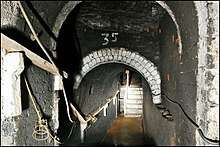
One mishap that occurred near the end of construction was the collapse of a 26-foot unlined section during April 1894, this event only blocked the tunnel for a week.[2] On 1 August 1894, the new tunnel was deemed to be suitable for use by Government inspector Major Yorke, allowing it to enter operational use shortly thereafter. The opening of the double-track tunnel provided sorely-needed additional capacity for the L&NWR, allowing them to implement temporary closures of the two single bores to allow for necessary maintenance work to be carried out without requiring the closure of the route.[2] As of 2018, the double-track bore hold the distinction of being the fifth-longest rail tunnel in Britain, coming after the new High Speed 1 tunnels, the Severn Tunnel on the Great Western Main Line, and the Totley Tunnel on the Sheffield to Manchester route.[17]
As of the present day, only the 1894 rail tunnel is still operational for rail traffic, although all three rail tunnels are still subject to extensive maintenance regimes.[2] During 1966, the original 1848 single-track rail tunnel was closed to traffic; it was followed by the 1871 single-track tunnel only four years later in 1970.[20] The 1848 tunnel provides an emergency escape route for the other tunnels, furthermore, it has been made accessible to road vehicles such as fire engines and ambulances to better facilitate such use. Both the 1848 and 1871 tunnel are used by maintenance personnel for access purposes as well.[2] During the 2000s, national rail infrastructure owner Network Rail proposed the reinstatement of rail traffic through the 1848 and 1871 tunnels as a means of increasing capacity on the Leeds-Manchester trans-Pennine route, however, following a re-appraisal in the light of the decision to electrify the trans-Pennine line, it was reported in 2012 that the reinstatement of either tunnel was considered to be unnecessary.[21]
Visitor Centre
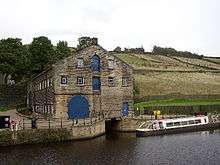
The Standedge Tunnel Visitor Centre at the Marsden end of the tunnel is located in the former warehouse used for transshipment of goods from canal barge to packhorse between 1798 when the canal reached Marsden and 1811 when the tunnel opened. The centre contains exhibitions on the history of the tunnels, the canal tunnel's recent restoration and the Huddersfield Narrow Canal. The Tunnel End Cottages, which formerly housed canal maintenance workers, currently houses both a cafe and the booking office for 30-minute boat trips into the tunnel. These tourist trips use electric tugs that push a passenger-carrying barge.
The visitor centre is about half a mile (0.8 km) west of Marsden railway station which can be reached via the towpath of the Huddersfield Narrow Canal which runs adjacent to the station. Adjacent to the railway station is the headquarters of the National Trust's Marsden Moor Estate which includes a public exhibition, Welcome to Marsden, that gives an overview of the area and its transport history.[22]
See also
References
Citations
- ↑ "Transportation Uses - Standedge Tunnels". standedge.co.uk. Retrieved 4 September 2010.
- 1 2 3 4 5 6 7 8 9 10 11 12 13 14 15 16 17 18 19 20 21 22 23 24 25 Bickerdike, Graeme. "The Standedge experience." Rail Engineer, 3 April 2014.
- ↑ Hadfield & Biddle 1970, pp. 322–323
- 1 2 Hadfield & Biddle 1970, pp. 324–325
- ↑ Hadfield & Biddle 1970, pp. 325–328
- 1 2 Skempton 2002, p. 495
- 1 2 Hadfield & Biddle 1970, pp. 328–329
- ↑ "Standedge Tunnel – A true wonder of the waterways". British Waterways. Archived from the original on 15 September 2012. Retrieved 23 January 2009.
- ↑ Hodge, Mary (1994). "The Saddleworth Story" (5th reprint ed.). p. 19. Archived from the original on 11 August 2007.
- 1 2 3 4 "Standedge Tunnel History". Pennine Waterways. Retrieved 26 September 2018.
- ↑ "Marsden History Group website". Archived from the original on 5 September 2010. Retrieved 4 September 2010.
- ↑ Rolt 1950, pp. 88–89
- ↑ "Media story & image of Historical Society boat trip from 1961". Retrieved 25 July 2009.
- ↑ "Modern Operation". Huddersfield Canal Society. Archived from the original on 26 October 2008. Retrieved 23 January 2009.
- ↑ "Standedge Tunnel". British Waterways. Retrieved 6 February 2011.
- ↑ "Standedge Tunnel Customer Guidelines" (PDF). British Waterways. Retrieved 6 February 2011.
- 1 2 "Communications and Transport in the Marsden area". Marsden Local History Group. Archived from the original on 31 December 2006. Retrieved 7 January 2007.
- ↑ "Huddersfield Narrow Canal Facts". Huddersfield One. Archived from the original on 7 January 2007. Retrieved 7 January 2007.
- ↑ Gagg 1976
- ↑ http://www.engineering-timelines.com/scripts/engineeringItem.asp?id=1459
- ↑ "Manchester Hub Rail Study" (PDF). Network Rail. p. 51. Archived from the original (PDF) on 7 June 2011. Retrieved 17 February 2010.
- ↑ "Marsden Moor – What to see and do". National Trust. Archived from the original on 22 July 2006. Retrieved 24 December 2006.
Bibliography
- Gagg, John (1976). Canal Tunnels. Bucks UK John Gagg. ISBN 9780950422626.
- Hadfield, Charles; Biddle, Gordon (1970). The Canals of North West England, Vol 2 (pp.241–496). David and Charles. ISBN 0-7153-4992-9.
- Rolt, L. T. C. (1950). The Inland Waterways of England. London: George Allen and Unwin Ltd. ISBN 0-04-386003-6.
- Skempton, Sir Alec; et al. (2002). A Biographical Dictionary of Civil Engineers in Great Britain and Ireland: Vol 1: 1500 to 1830. Thomas Telford. ISBN 0-7277-2939-X.
External links
| Wikimedia Commons has media related to Standedge Tunnels. |
- Internal Standedge tunnel pictures can be seen here
- Aerial photos of the Diggle portal and the Marsden portal
- Standedge Tunnel Visitor Centre
- Waterscape services directory
- Standedge Tunnel
- A walk between Marsden Station and Standedge Tunnel from TripsByTrain.com
| Records | ||
|---|---|---|
| Preceded by Sapperton Canal Tunnel |
Longest tunnel 1811–1871 |
Succeeded by Fréjus Rail Tunnel |